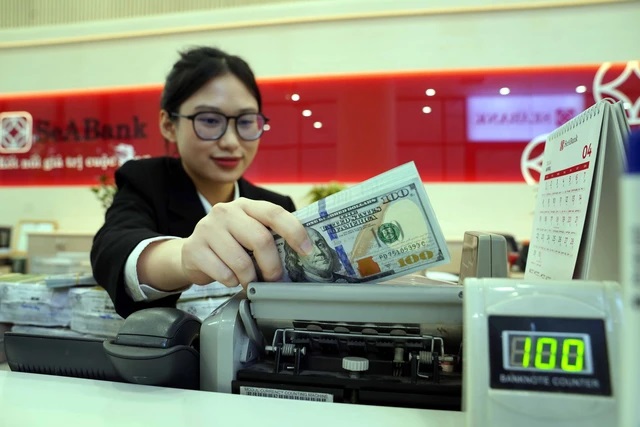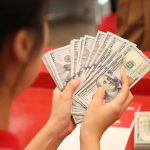On August 19, the State Bank of Vietnam set the daily reference exchange rate at 24,261 VND/USD, an increase of 8 VND compared to the previous week. Since the beginning of August, the reference exchange rate has risen by approximately 16 VND (+0.06%).
Meanwhile, commercial banks have reported a continuous decline in USD rates. At 11 am, Vietcombank quoted a buying rate of 24,860 VND/USD and a selling rate of 25,200 VND/USD, a decrease of 30 VND from the previous week. Since the beginning of August, the USD rate at this bank has dropped by 200 VND.
Eximbank set the buying rate at 24,850 VND/USD and the selling rate at 25,170 VND/USD.
Sacombank offered a buying rate of 24,850 VND/USD and a selling rate of 25,180 VND/USD.
Not only have commercial bank USD rates fallen, but the black-market rates have also taken a surprising tumble, dropping by 100 VND. Some foreign exchange outlets in Ho Chi Minh City are now offering a buying rate of 25,298 VND/USD and a selling rate of 25,378 VND/USD.
The black-market rates are now only about 200 VND higher than the commercial bank rates.

Commercial bank USD rates have declined significantly since the beginning of August
|
The decrease in domestic USD rates comes as the US Dollar Index (DXY) on the international market has also cooled off. The DXY fell further to 102.2 points this morning.
According to analysts, the US dollar has eased as the US Federal Reserve (Fed) is expected to begin its first interest rate cut in September, with potentially two rate cuts expected this year.
The analysts also attributed the reduction in pressure on the exchange rate since July to the State Bank’s effective intervention through foreign currency sales, as well as the maintenance of high interbank interest rates, which has helped narrow the interest rate gap between the USD and VND, thereby supporting the depreciation of the VND.
Year-to-date, the USD/VND exchange rate at commercial banks has increased by only about 2.8%. This is significantly lower than the peak of approximately 4.9% reported by the State Bank in mid-April.
According to ACBS Securities Company, the State Bank has implemented various measures to stabilize the exchange rate, including managing VND liquidity in the interbank market through the issuance of bills, open market operations (OMO), and increasing bill and OMO interest rates. They have also sold foreign currency to ease supply and demand tensions. The pressure on the USD/VND exchange rate is expected to ease by the end of the year.
Many analysts predict that the exchange rate pressure will continue to ease through the end of the year as the Fed cuts interest rates and Vietnam’s macroeconomic data remains positive, supported by a trade surplus, FDI disbursements, remittances, and international tourism.
Thai Phuong, Photo: Lam Giang








































